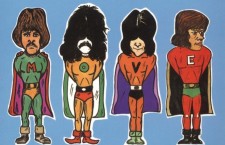One of the more improbable comebacks in rock history was about to reach its summit when Roy Orbison suddenly died in December of 1988. Mystery Girl, released on Feb. 7, 1989, became his final triumph — capping a period filled with them.
Roy Orbison passed even as “Handle With Care,” sung with the newly formed all-star Traveling Wilburys, was moving up the Billboard charts. That followed Orbison’s then-recent induction into the Rock and Roll Hall of Fame, his participation in a vital Sun Records reunion, a re-recording of all of his greatest hits, a Grammy win for a duet on “Crying” with k.d. lang, and the sight of his song “In Dreams” moving back into the zeitgeist after its inclusion in the film Blue Velvet. Suddenly, Roy Orbison — the yearning former rockabilly star — was everywhere. Then, alas, he was gone.
His sudden loss, and the album that would follow, would resonate in ways it might not have before. Mystery Girl, which saw an expanded Legacy repackaging in 2014, would emerge as a celebration, a valedictory, a mash note and a desperately sad farewell — all in one.
The Wilbury supergroup emerged from the era that produced Mystery Girl, and as such it also included Roy Orbison’s bandmates Jeff Lynne, George Harrison and Tom Petty — who brought along most of the Heartbreakers, since they were sharing studio time in guitarist Mike Campbell’s studios. Orbison collaborated with Lynne to create “You Got It,” which became his first Top 10 hit since the early 1960s.
Elsewhere, Bono gave him a track, as did Billy Burnette and Elvis Costello, each of them seeming to arrive with a dream-like synchronicity. Roy Orbison could also be found once again singing a trio of songs created in collaboration with Bill Dees — with whom he had worked on countless early-period classics, perhaps most notably “Oh, Pretty Woman.”
Last year’s reissue featured all 10 original cuts, plus nine unreleased tracks — most of them early demos, though one (“The Way Is Love”) was a newly restored song that saw Roy Orbison’s three sons providing new backing accompaniment on a leftover vocal track from their father. Also included was a documentary featuring a song-by-song look into the creation of Mystery Girl, with additional archival footage from the sessions and interviews with Lynne, Steve Cropper (who sat in on “The Only One”), Campbell, Jim Keltner (drummer on six tracks), Burnette and Petty, among others. There were eight Orbison music videos, half of which have never before been seen, as well as a feature on the contemporary sessions for “The Way Is Love.”
This album’s transformative quality, however, can be found not with its famous guests but in that voice.
Unbent by age, it remained a clarion call of emotion — though utterly changed, anyway. While so much of Roy Orbison’s initial discography had been bound up in a depthless sadness, Mystery Girl opened up into sun-drenched vistas of joy. Orbison, more than just being famous again, was in love. His wife Barbara was the mystery girl in question, course. She inspired him toward this return, toward this album, toward ageless moments like “A Love So Beautiful,” which was cut in one thunderously enraptured take.
Roy Orbison, for the briefest of moments, was born anew.
- How Deep Cuts on ‘Music From Big Pink’ Underscore the Band’s Triumph - July 31, 2023
- How ‘Islands’ Signaled the Sad End of the Band’s Five-Man Edition - March 15, 2022
- The Band’s ‘Christmas Must Be Tonight’ Remains an Unjustly Overlooked Holiday Classic - December 25, 2016




